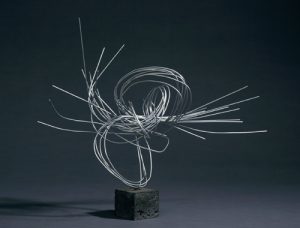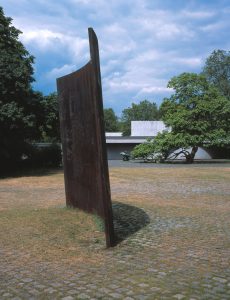The prizewinners
In 1996, Spanish sculptor Eduardo Chillida (1924-2002) became the first recipient of the Wilhelm Lehmbruck Prize. He is regarded as one of the most important 20th century Spanish sculptors and became known for his monumental abstract works made of steel, many of which stand in public spaces – for example what is perhaps his best known work in Germany, the group “Unity” in front of the Federal Chancellery in Berlin. The Lehmbruck Museum also owns works by the artist.
Five years later, in 1971, Norbert Kricke (1922-1984), who was born in Düsseldorf was the next winner – an artist who remained resolutely dedicated to the figurative sculptures of his artistic beginnings in abstraction. Using bent wire and rods he made simple, space-consuming sculptures such as “Hornisse” (1955), which the Lehmbruck Museum owns. Numerous works by Kricke are to be found in public spaces, among them the “Mannesmannplastik” in Düsseldorf and a large wall relief on the Musiktheater im Revier building in Gelsenkirchen.

Norbert Kricke, Hornet, 1955/56, Photo: Jürgen Diemer
In 1976, in the person of Jean Tinguely (1925-1991) the prize went to an artist who featured the element of movement in his works. Put together using iron parts, scrap, and other materials, the constructions are for the most part cheery, tongue-in-cheek machines which, clanking with various degrees of loudness, enthral their observers. They stand in contrast to all materials and principles otherwise used in sculpture and are as subversive as they are entertaining. Tinguely’s works represent a unique contribution to art. The Lehmbruck Museum showcases “Das kleine Männchen” (1981) and “Märchenrelief” (1978) in its permanent exhibition.
Everyday objects in unusual sizes and combinations feature in the oeuvre of Claes Oldenburg (born 1929), who was awarded the Wilhelm Lehmbruck Prize in 1981. He became famous among other things for sculptures of over-sized tools, such as his 12-meter high pickaxe for the documenta 7 exhibition in Kassel and the more than 10-meter high fluttering tie in front of a skyscraper in Frankfurt/Main, which pokes fun at the forever smartly dressed office staff who work in the high-rise. Until her death in 2009 Oldenburg collaborated with his wife Coosje van Bruggen on major projects. For the Lehmbruck Museum he designed “Tools of the Trade – Project for Duisburg”, which was intended to be an intervention on the new building. There is a model of the sculpture in the museum’s collection.
Joseph Beuys (1921-1986) received the Wilhelm Lehmbruck Prize in 1986. With the term “social sculpture” he introduced a new category to art; it derived from his intense study of humanism, social philosophy, and anthroposophy. This led to the “expanded concept of art” that Beuys formulated, with which as of the late 1970s he called for the democratic, creative, joint shaping of society and politics by everybody. In his speech he surprised those listening by revealing a close relationship with Wilhelm Lehmbruck’s oeuvre. The 1981 installation “Raum 90 000 DM” is part of the museum’s collection.
Steel is one of the favourite materials of US sculptor Richard Serra (born 1939), who was awarded the Wilhelm Lehmbruck Prize in 1991. As a rule, Serra uses Corten steel that rusts evenly on the surface only, which gives his works a particular aura. What often appears to be a risky game involving carefully balanced, monumental expanses is one of the main features of his oeuvre. Some of the objects are huge, such as “The matter of Time”, for which a 130-meter long and 30-meter wide hall was purpose-created at the Guggenheim Museum in Bilbao. These to a greater or lesser extent sweeping, curved giant steel panels give rise to a totally new perception of space in the observers standing in front of or walking through them.

Richard Serra, Weitmar, 1984 © VG Bild-Kunst, Bonn 2020, Photo: Werner Hannapel
In the 1970s a whole host of artists left their studios and used the open countryside to create what were often temporary interventions that, for the most part, were difficult to reach. The main proponent of this trend, which came to be known as Land Art, was Richard Long (born 1945), and he won the Wilhelm Lehmbruck Prize in 1996. He went on hikes almost all over the world and recorded impressions of the countryside and the stone and wooden sculpture he created there in photographs and texts. Using stones or driftwood he collected he laid out geometric shapes in museums and galleries that are representative of the works created in the countryside. For the exhibition that goes with the prize Richard Long created the “River Avon Mud Circle” out of dried mud, which he applied over the circle using his own hands and which has since been on display on a wall in the new building at Lehmbruck Museum.
Works by Korean artist Nam June Paik (1932–2006) were technically complex and at the cutting edge of electronic media. As of 1960 he worked with electronic music, experimented later on with TV images, and built small musical objects, which he included in his activities. As of 1965 he was the first artist to begin working with video (a totally new medium at the time) which he integrated in an extremely flexible, differentiated manner in his installations. The museum’s collection includes his piece entitled “TV-Buddha” (1997) and he was awarded the Wilhelm Lehmbruck Prize in 2001.
Soft/hard, bright/dark, light/heavy, relaxed/tense are polar opposites, which Reiner Ruthenbeck (1937–2016) used to describe his works, for which he was awarded the Wilhelm Lehmbruck Prize in 2006. Using black and claret fabrics he made objects that introduced a totally new aspect to the sculptural world: By way of example, he hung panels, panes of glass and sand freely in spaces or on walls using sacks and receptacles reminiscent of swings or sewn together like bags. The work “Aufhängung V” (1969–1970) is typical of the artist and part of the Lehmbruck Museum’s collection.
In 2017 and following a break of 11 years, the Wilhelm Lehmbruck Prize was awarded to Rebecca Horn (born 1944). After more than 50 years she was the first female artist to be honoured. The prize went to Rebecca Horn for her life’s work: She has been a major influence on 20th and 21st century sculpture. As a sculptor, illustrator, writer, film maker, and video, installation and performance artist, over the past few years Rebecca Horn has created an extensive, coherent body of work, which develops a mechanical poetry all of its own.
Due to the generous support of the Rhineland Regional Council (LVR), the internationally renowned Wilhelm Lehmbruck Prize was most recently awarded to Janet Cardiff (born 1957) and George Bures Miller (born 1960) in 2020 only three years after the last award. The arists shaped an entire genre through their multimedia work that touches on genres diverse as theater, cinema, music, sound art and audio drama. It opens up new dimensions in sculpture in the 20th and 21st centuries.